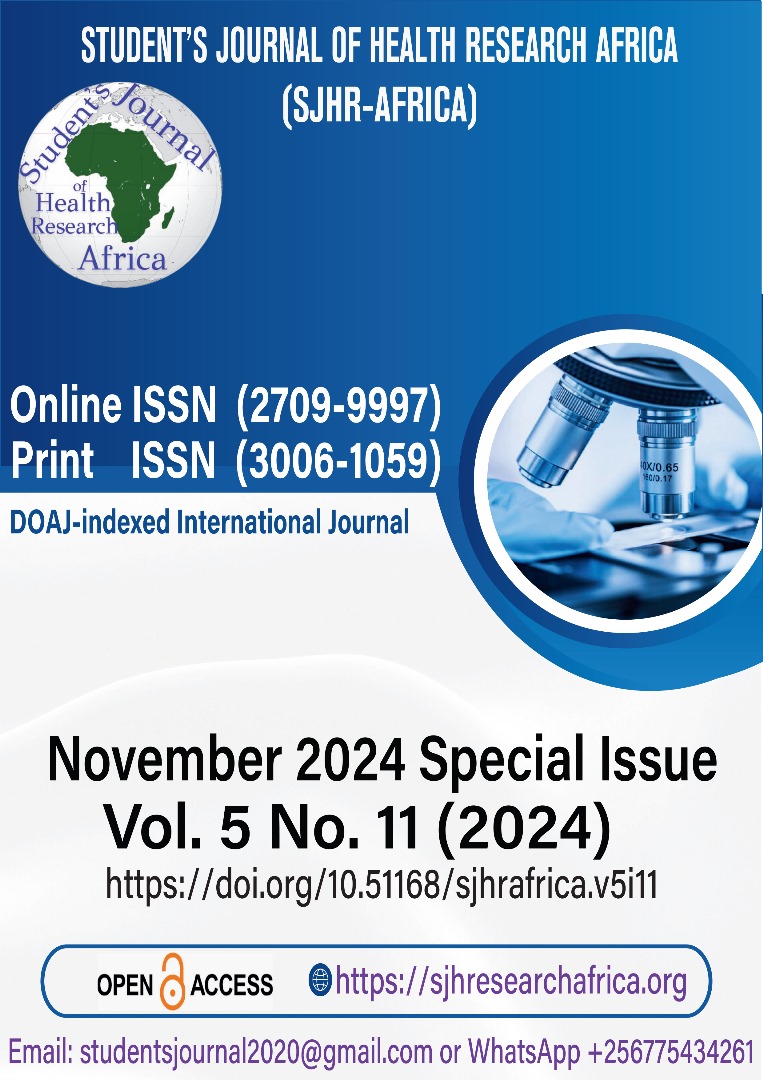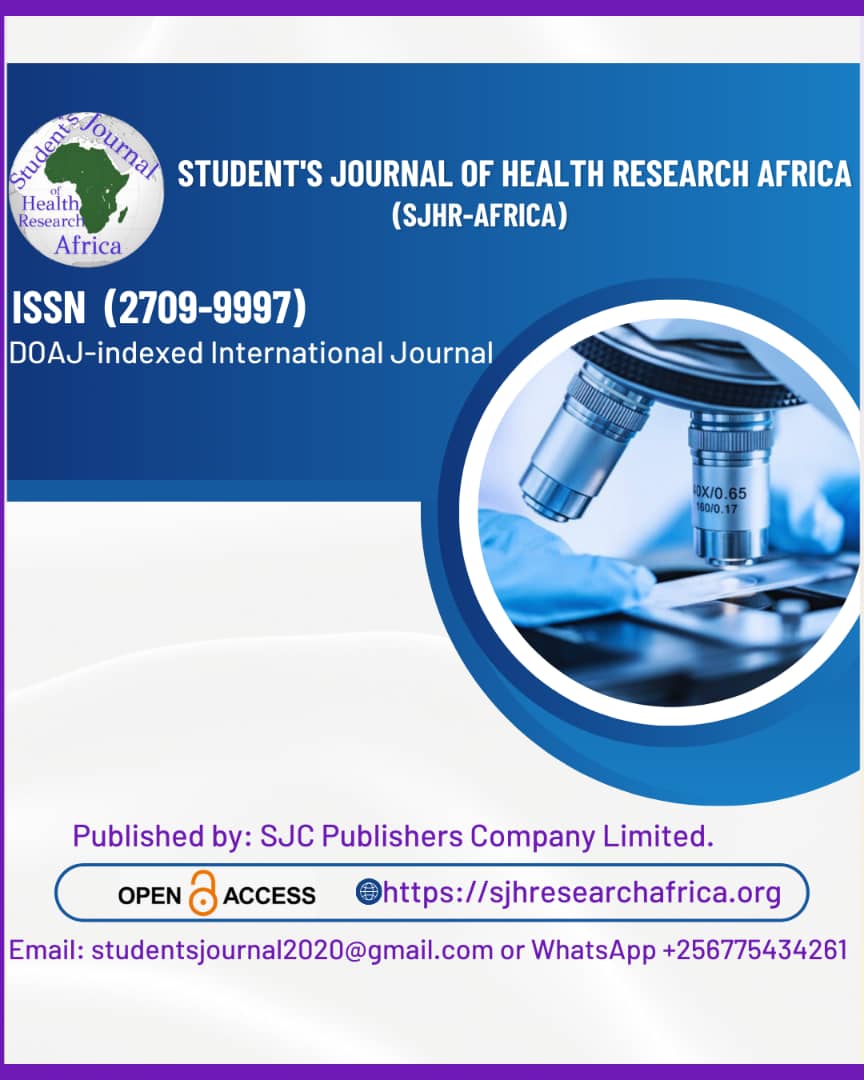HAZARDS OF MEDICAL GLAUCOMA THERAPY IN THE CATARACT PATIENT
DOI:
https://doi.org/10.51168/sjhrafrica.v5i11.1748Keywords:
Glaucoma, cataract, anti-glaucoma drugs, phacoemulsification, ocular surface disease, zonular weakness, visual outcomeAbstract
Background
Cataracts and glaucoma are major causes of vision impairment worldwide, particularly among seniors. These disorders often coexist due to risk factors like aging and ocular hypertension. Anti-glaucoma medications are the main way to lower intraocular pressure (IOP), but prolonged use can damage the ocular surface, lens, and tissues, which can complicate cataract formation, progression, and surgery.
Objective: Examine the impact of long-term medical glaucoma treatment on cataract surgery outcomes, including preoperative status, intraoperative difficulty, and postoperative outcomes.
Methods
A total of 97 individuals with age-related cataracts and a history of chronic medical glaucoma therapy (≥6 months) were included. The eye exam included visual acuity, slit-lamp biomicroscopy, fundus evaluation, intraocular pressure measurement, gonioscopy, and ocular surface analysis. The classification, quantity, and duration of anti-glaucoma drugs were recorded. Intraoperative and postoperative issues occurred during phacoemulsification or SICS, as well as visual recovery.
Results
58.8% of 97 patients received multiple anti-glaucoma medications, with 76.3% receiving treatment for over 12 months. Ocular changes included conjunctival hyperemia (47.4%), superficial punctate keratitis (28.9%), pseudoexfoliation (25.8%), and lens subluxation (11.3%). In the procedure, 19.5% had inadequate pupillary dilatation, 12.4% had zonular weakness, and 8.2% needed capsular tension rings. Postoperative inflammation and delayed epithelial repair were more common in multi-drug users. Despite significant BCVA improvement for most patients, 13.4% had inadequate recovery due to pre-existing optic nerve injury and surgical issues.
Conclusion
Long-term glaucoma treatment, particularly with multiple drugs, can harm ocular tissues and complicate cataract surgery. Conjunctiva, lens capsule, corneal epithelium, and zonular apparatus changes may increase surgical risk and postoperative recovery. These risks must be identified early for preoperative planning and patient consultation. Ophthalmologists must weigh the risks and benefits of prolonged topical anti-glaucoma treatment for cataract patients with glaucoma.
References
Arita, R., Itoh, K., Maeda, S., Maeda, K., Furuta, A., & Fukuoka, S. (2015). Effects of long-term anti-glaucoma medications on ocular surface. Clinical Ophthalmology, 9, 2127-2133.
Baudouin, C., Labbe, A., Liang, H., Pauly, A., & Brignole-Baudouin, F. (2010). Preservatives in eyedrops: The good, the bad, and the ugly. Progress in Retinal and Eye Research, 29(4), 312-334. https://doi.org/10.1016/j.preteyeres.2010.03.001 PMid:20302969
Brandt, J. D., Wittpenn, J. R., Katz, L. J., Steinmann, W. C., & Chen, K. (2001). Conjunctival changes related to medications in chronic glaucoma. Current Opinion in Ophthalmology, 12(2), 149-152.
Chua, B. E., Quigley, H. A., & West, S. K. (2016). Long-term use of anti-glaucoma medications: Effects on ocular surface and cataract surgery outcomes. American Journal of Ophthalmology, 172, 125-133.
Gedde, S. J., Schiffman, J. C., Feuer, W. J., et al. (2004). Treatment outcomes in the Tube Versus Trabeculectomy Study after one year of follow-up. American Journal of Ophthalmology, 138(3), 338-347.
Inoue, K., Shiokawa, M., Higa, R., Wakakura, M., Tomita, G., & Iwao, K. (2011). Effects of anti-glaucoma eye drops on corneal epithelial barrier function. Clinical Ophthalmology, 5, 1671-1676.
Iwase, A., Suzuki, Y., Araie, M., et al. (2013). The impact of anti-glaucoma medication on cataract development. Japanese Journal of Ophthalmology, 57(6), 519-525.
Kim, J. H., Kang, S. Y., Song, B. J., & Kim, J. M. (2016). Influence of chronic anti-glaucoma medication use on zonular integrity during cataract surgery. BMC Ophthalmology, 16(1), 154. https://doi.org/10.1186/s12886-016-0321-2 PMid:27580699 PMCid:PMC5007688
Leung, E. W., Medeiros, F. A., & Weinreb, R. N. (2008). Prevalence of ocular surface disease in glaucoma patients. Journal of Glaucoma, 17(5), 350-355. https://doi.org/10.1097/IJG.0b013e31815c5f4f PMid:18703943
Noecker, R. J., Herrygers, L. A., & Anwaruddin, R. (2004). Corneal and conjunctival changes caused by commonly used glaucoma medications. Cornea, 23(5), 490-496. https://doi.org/10.1097/01.ico.0000116526.57227.82 PMid:15220734
Pillunat, L. E., Erb, C., Jünemann, A. G., & Kimmich, F. (2020). Micro-invasive glaucoma surgery (MIGS): A review of surgical procedures using stents. Clinical Ophthalmology, 14, 1977-1988.
Pisella, P. J., Debbasch, C., Hamard, P., et al. (2002). Conjunctival epithelial cell death induced by topical anti-glaucoma drugs. Cornea, 21(3), 285-291.
Quigley, H. A., & Broman, A. T. (2006). The number of people with glaucoma worldwide in 2010 and 2020. British Journal of Ophthalmology, 90(3), 262-267. https://doi.org/10.1136/bjo.2005.081224 PMid:16488940 PMCid: PMC1856963
Ritch, R. (2001). Exfoliation the most common identifiable cause of open-angle glaucoma. Journal of Glaucoma, 10(5 Suppl 1), S85-S89. https://doi.org/10.1097/00061198-200110001-00013 PMid:11890270
Schlötzer-Schrehardt, U., & Naumann, G. O. (2006). Ocular and systemic pseudoexfoliation syndrome. American Journal of Ophthalmology, 141(5), 921-937. https://doi.org/10.1016/j.ajo.2006.01.047 PMid:16678509
Skalicky, S. E., Goldberg, I., & McCluskey, P. (2012). Ocular surface disease and quality of life in patients with glaucoma. American Journal of Ophthalmology, 153(1), 1-9. https://doi.org/10.1016/j.ajo.2011.05.033 PMid:21872203
Steven, P., Lechner, V., & Geerling, G. (2018). Ocular surface disease in glaucoma patients: A review. Ophthalmic Research, 60(2), 94-102.
Tham, Y. C., Li, X., Wong, T. Y., Quigley, H. A., Aung, T., & Cheng, C. Y. (2014). Global prevalence of glaucoma and projections of glaucoma burden through 2040. Ophthalmology, 121(11), 2081-2090. https://doi.org/10.1016/j.ophtha.2014.05.013 PMid:24974815
Weinreb, R. N., Aung, T., & Medeiros, F. A. (2014). The pathophysiology and treatment of glaucoma: A review. JAMA, 311(18), 1901-1911. https://doi.org/10.1001/jama.2014.3192 PMid:24825645 PMCid: PMC4523637
Downloads
Published
How to Cite
Issue
Section
License
Copyright (c) 2024 Govind Kumar Mandal, Pummy Roy, Jagdish Choudhary

This work is licensed under a Creative Commons Attribution-NonCommercial-NoDerivatives 4.0 International License.






















